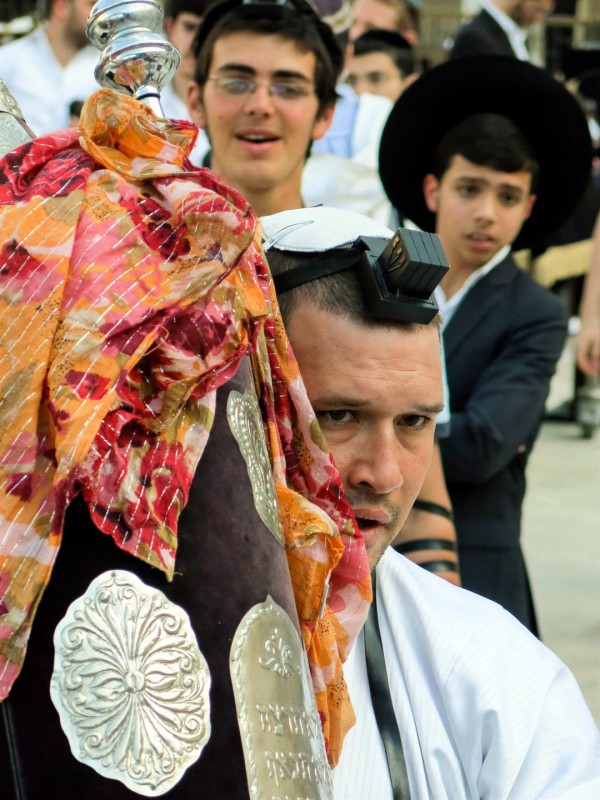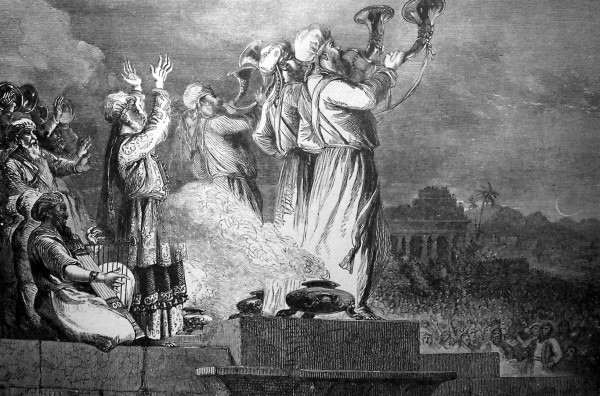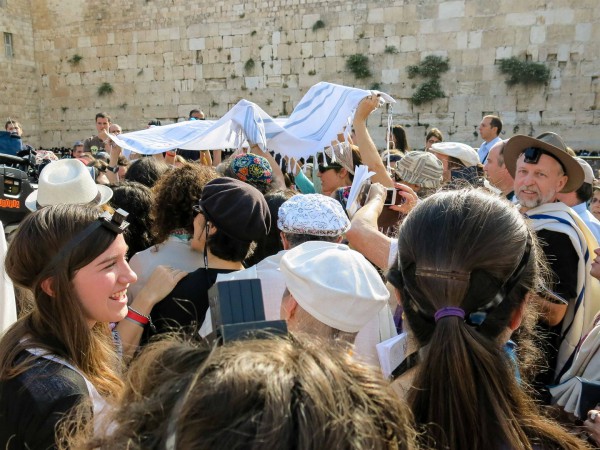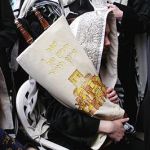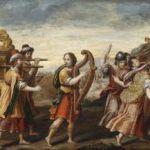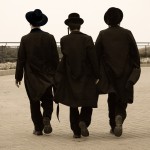
Around this time, people ask us when Rosh HaShanah (the Hebrew New Year) begins, since this holiday can fall in September or October.
When is Rosh HaShanah? The Hebrew date is always the same — the 1st of Tishrei. But, of course, people are really wondering what date the holiday falls on the Gregorian calendar.
This year, Rosh HaShanah begins at sunset on Wednesday, October 2 — so it is just a week away.
The dates of Jewish holidays don’t change from year to year; however, a Jewish year can change in length from 353 to 354 or 355 days long. A nd a Jewish leap year can be 383, 384 or 385 days long.
Because the Jewish year is not the same length as the year on the civil calendar, the dates of holidays seem to shift quite a bit.

September calendar with High Holy Days circled.
Why are the two calendars so different in length?
The civil Gregorian calendar is based on the solar cycle of 365 days, five hours, 48 minutes and 46 seconds — the amount of time it takes the earth to make one complete rotation around the sun.
To correct the problem of those extra hours, an extra day is added to February every four years. This keeps the equinox (when the sun shines directly on the equator) occurring on generally the same date every year: March 19 or 20 and September 22 or 23.
The Jewish calendar is a luni-solar calendar. It considers three things: the yearly rotation of the earth around the sun, the daily rotation of the earth on its own axis, and the monthly cycle of the moon around the earth.
Each new moon cycle begins a new month or Rosh Chodesh. However, there are approximately 12.4 lunar months in every solar year. In other words, a lunar year is about 11 days shorter than a solar year.

Orthodox Jewish man blows a shofar (ram’s horn).
If the Jewish calendar were a strict lunar calendar that has 29.5 days in a month, every 16 years or so the Fall Feasts would be held in Spring, and the wheat harvest festival of Shavuot / Pentecost would be held in autumn. This is the case with the Islamic month of Ramadan that shifts throughout the seasons making a full cycle every 33 years.
To keep the Jewish holidays and appointed times in their correct seasons, every two or three years the month of Nissan begins earlier and an extra month is added. This 13-month year is called Shanah Me’uberet, literally, a pregnant year.
The additional month of Adar 1 (also called Adar Aleph) is added before Adar, which is then designated Adar 2. Interestingly, Adar 1 is not used for celebrating such things as Yahrzeits (anniversary of a death), Bar Mitzvahs and birthdays. Adar 2 is considered the real month for honoring such occasions.
The addition of the extra month guarantees that Passover (Pesach) and the wheat harvest feast (Pentecost /Shavuot) occurs in the Spring. There is still a slight shifting, however, that results in the Jewish High Holidays falling anywhere from early September all the way into October.
The Jewish calendar that is used today, which follows a 19-year cycle, realigning the lunar and solar calendars was established by Hillel II, the Nasi (Prince) of the ancient Jewish Sanhedrin during his leadership between AD 320 and 385.
Between AD 320 and 385, Hillel II, the Nasi (Prince) of the ancient Jewish Sanhedrin, established the calendar that is used today, which follows a 19-year cycle, realigning the lunar and solar calendars.
In this system the extra month is added on the 3rd, 6th, 8th, 11th, 14th, 17th and 19th years of the cycle. The current cycle began at the start of the Jewish year 5777, which occurred on October 3, 2016.
The Gregorian calendar, however, was created in 1582 by Pope Gregory XIII and proclaimed the official civil calendar of Britain and the British colonies of America in 1752.

The new moon phase is the moon at its darkest in the night sky. The sky almost appears to have no moon at all.
Celebrating Rosh Chodesh, the New Month
“And on your joyous occasions — your fixed festivals and new moon days — you shall sound the trumpets over your burnt offerings and your sacrifices of well-being.” (Numbers 10:10)
The beginning of a new month is pivotal in the Jewish calendar because all of the holidays are marked by their month.
Every month is either 29 days (known as Chaser or lacking, in Hebrew) or 30 days (Malei or full). The beginning of the month is called Rosh Chodesh (ראש חודש / Head of the Month).
In Biblical times and today, Rosh Chodesh itself is considered a minor holiday, much the same as the intermediate days of Passover.
In the Book of Samuel, we see that the new moon was honored with a feast:
“David said to Jonathan, ‘Behold, tomorrow is the new moon, and I should not fail to sit at table with the king. But let me go, that I may hide myself in the field till the third day at evening.’… So David hid in the field, and when the New Moon feast came, the king sat down to eat.” (1 Samuel 20:5, 24)

Although Jewish men and women celebrate Rosh Chodesh, women have a special connection to this semi-holiday. It is traditionally believed that because the women refused to relinquish their jewelry to the men in the incident of the Golden Calf, they were given this special day as a kind of holiday. The expressions of that holiday differ from community to community. (Photo by Brian Negin)
Even today we see vestiges of celebrating the new moon:
“When I was a young boy attending a Hebrew Institute, once a month we would have a party in celebration of the new moon or the beginning of the new Hebrew calendar month,” said a member of the Bibles For Israel team. “This meant an hour or so away from our studies when we could drink juice, eat fruit and just have fun.”
On the Sabbath of Blessing of the Month (Shabbat Mevarkhim HaChodesh), which is the last Sabbath before Rosh Chodesh, additional prayers are recited to create spiritual sustenance for the coming month.
The blessing asks God to renew the month “for life and for peace, for gladness and for joy, for deliverance and for consolation.”
Sometimes the Sabbath before Rosh Chodesh is just a day before. In that case, the Sabbath is called Shabbat Machar Chodesh (Shabbat of tomorrow’s moon).
If the Sabbath falls on the new moon, it is called Shabbat Rosh Chodesh and additional Torah (Numbers 28:11) and Haftarah (Isaiah 66:23) readings are added.
The Shabbat Rosh Chodesh Torah reading describes the Rosh Chodesh offerings at the Temple:
“At the beginning of each of your months you shall present a burnt offering to the LORD: two bulls and one ram, seven male lambs one year old without defect.” (Numbers 28:11)
The Haftarah portion reveals that the nations will come to Jerusalem at the new moon to worship before the Lord when Messiah returns:
“‘From one New Moon to another and from one Sabbath to another, all mankind will come and bow down before Me,’ says the LORD.” (Isaiah 66:23)
This reveals that God has not and will not abandon His appointed times.
Sanctification by the Sanhedrin
On Shabbat Mevarkhim (the Shabbat that blesses the new month), we remember the Sanhedrin’s role in sanctifying this new moon, which was not always easy to spot in the sky.
During its rebirthing phase, the moon rises and sets with the sun for one or two days. Because of its proximity to the sun during this time, the moon is difficult to impossible to see.
After its apparent absence, it reappears in the western night sky as a faint sliver.
In ancient times, the Sanhedrin (also known as the rabbinical council) would only declare a Rosh Chodesh on the testimony of two reliable witnesses.
In a large courtyard called Beit Ya’azek, members of the rabbinical council would question witnesses who had claimed to have seen the new moon the previous day.
The members of the Sanhedrin knew astronomy well and thus knew which questions to ask. They knew when the new moon was to appear and where it could be seen. Nevertheless, the sanctification of the moon required the testimony of two witnesses who had actually seen it.
As the witnesses arrived they would ask the following questions:
- In which direction was the moon in relation to the sun?
- Was it to the north or south?
- How high in the sky did the moon appear?
- In which direction were the crescent’s tips facing?
- How wide was it?
In each case, they would first question the older member of the pair and then the younger. If their testimonies matched, they would proclaim the 30th day as Rosh Chodesh making that a 29 day month, and say, “Mekudash! (Sanctified!).” With everyone responding, “Mekudash! Mekudash!” (Chabad)
If no witnesses were found, the following day was celebrated as Rosh Chodesh and the previous month became a 30-day month.
The Midrash (book of rabbinic stories and teachings) teaches that the Jewish people who are holy (“And you shall be holy to Me, for I, the Lord, am holy” (Leviticus 20:26)) sanctify (make holy) the new moon through their blessings of it.
Today, shortly after Rosh Chodesh every month, Jewish people go outside in a group to recite the kiddush levanah prayer (literally, sanctification of the moon), in which we praise God:
“And He directed the moon to renew herself as a crown of glory to [the Jewish nation], who likewise are destined to be renewed like her …” (Chabad)
Rosh Chodesh is thus seen as a kind of second chance. It is a monthly reminder: just as the moon is renewed from almost complete extinction “emitting not an iota of light,” we are likewise “destined to be renewed like her.”
In Judaism this renewal is seen as a national rebirth when the Messiah returns, which will be shared by the entire world. (Chabad)
Just as the moon wanes every month, the Jewish nation seemed to wane after the days of Solomon. Nevertheless, Israel will be restored to her full brightness, and the entire world will be impacted.

Jewish new moon celebration (Illustration from Juedisches Ceremoniel, a German book published in 1724)
New Moon, New Life
The rebirth of the moon at Rosh Chodesh reminds us of the birth of our own lives. It, in essence, reminds us to approach God as a child in simplicity, seeking a one-to-one connection with Him.
To accomplish this, a person must relate to God completely devoid of his own personal qualifications in a sense of what the sages call mesirat nefesh — self-nullification or self-sacrifice in God’s service. Children, with their simple outlook on life, have no need to negate their existence in order to connect with God.
Rabbi Yossi Braun, writing for the Chabad website, also compares the new month to the birth of a child which always brings on a shower of mazel tovs (congratulations) and good feelings.
Even though babies cannot determine if they will have much to offer when they become full grown, each of us rejoices at the birth of a child because we’re so glad that God has given us a new life.
“The reason we love children so much is because of their innocence, simplicity, and purity. In truth, we don’t appreciate them for their virtues, for what they have, but for what they lack,” writes Braun.
Children, he says, are not trying to prove anything; they just want to exist. “We celebrate our children for who they are, or more correctly, because they are,” writes Braun.
This step of passing into creation is a greater achievement than any subsequent transitions says Braun. All future achievements are built on this one thing: the very fact that the child exists.
And this is how the Jewish People relate to the moon. At the middle of the month the moon is round and full and has reached its perfection — but at Rosh Chodesh when it is a thin sliver, we celebrate the mere fact that it exists at all.
Braun compares this with the life of each individual. “As a people, too,” he writes, “we have had different phases: our better days when everything was dandy and rosy, and our end-of-the-month waning times. But, we celebrate the fact that despite all odds, we exist. We are. And we’re here to stay.”
It surely seems that the Jewish People were at times throughout history “about to disappear from planet Earth — but so does the moon. The shining of the moon anew each month reassures us of our ultimate rebirth — the Redemption,” Braun concludes.
Consequently, the rebirth of the moon each month can be for us a reminder of this rebirth, of this redemption from sin and death.
The phases of the moon remind us that no one is perfect and that although we may fall, we are never diminished in God’s sight.
“The righteous can fall even seven times, and rise again; but the wicked stumble with evil.” (Proverbs 24:16)
The righteous fall but they get up again. Just as the moon rises and then declines, we are reminded of the high and low points in everyone’s lives. And just as the moon keeps coming back each month, we must never give up.
Similarly, just as the waning of the moon suggests its extinction, it reminds us that at the darkest of times, when the Divine Presence seems to have left our world, it is really only hidden from our view.
The Final Redemption — The Messianic Rebirth
Although the rabbis compare the coming Messianic era to the full moon, the hope of redemption and His coming is compared to the new moon.
Its re-emergence is compared to the kingdom of David. “Though it may have lost much of its former radiance, it will be restored to its glory in messianic times,” the Chabad website states.
“Once I have sworn by My holiness; I will not lie to David. His descendants shall endure forever and his throne as the sun before Me. It shall be established forever like the moon, and the witness in the sky is faithful.” (Psalm 89:35–37)
The Talmud (compendium of rabbinical teachings and discussions) teaches that when the Messiah returns, the moon will cease to diminish and remain as large and bright as the sun.
So while the celebration of the new moon reminds us of His coming, it also reminds us to renew our awareness of His Presence in our lives, and to push forward into the growth and change that He has for us, becoming all He created us to be.
“When I look at your heavens, the work of your fingers, the moon and the stars, which you have set in place, what is man that you are mindful of him, and the son of man that you care for him?” (Psalm 8:3–4)




